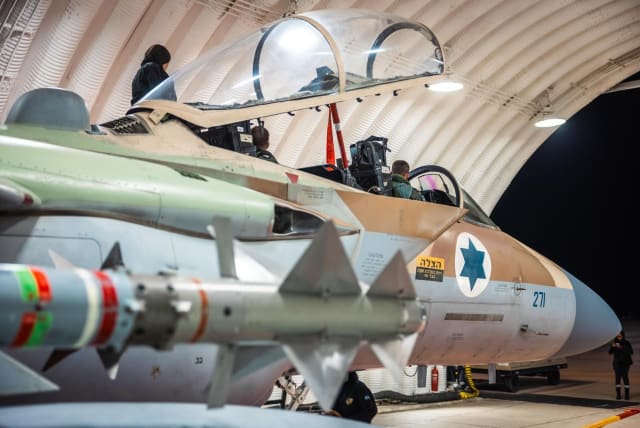Ex-Air Force chief: Israeli air defense must adopt new strategies, invest in laser defense

The future threats and the cost of the arms race with Jerusalem’s adversaries require adopting a new and forward-looking strategy.
Israel must move its air defense toward integrating lasers with its aircraft to maximize the flexibility and interoperability of fighter jets to act both on offense and defense, former Air Force chief David Ivri said on Sunday.
Speaking at a Tel Aviv University Conference on air defense following Hamas’s October 7 invasion and Iran’s April 14 massive aerial attack, Ivri complained that Israel has not sufficiently invested in and prioritized laser defense.
Israel must adopt a new forward-looking strategy
According to the former IAF commander, Israel has gotten stuck in its pride for existing strong air defense systems like the Iron Dome and the Arrow 3, whereas the future threats and the cost of the arms race with Jerusalem’s adversaries require adopting a new and forward-looking strategy.
Ivri said that if Israel had been investing sufficiently in laser air defense and integration of that air defense with fighter jets, it would already have achieved operational capabilities.
In contrast, The Jerusalem Post has learned that Israel is only expected to be able to fully use laser defense at initial ground levels (integrating with aircraft would be much farther off) toward the end of 2025.
This would be significantly slower than former prime minister Naftali Bennett’s prediction of being able to use lasers for real defense by sometime in 2023 or 2024. It would also be longer than Rafael CEO Yuval Steinitz’s one-time statement that early laser deployment would be ready by August 2024 (sources later said that he was referring to internal testing operational capabilities but not actual deployment against Hamas or Hezbollah).
It would also be longer than former IDF chief Aviv Kohavi’s prediction of operability around the start of 2025.
At the same conference, former air defense chief and IDF chief spokesman Brig.-Gen. (res.) Ran Kochav said “this war is challenging us in every area. International cooperation has been profound and the joint drills worked.”
Israel must prepare itself for the next threat
Kochav warned that Israel, “needs to get ready for the next threat, for the next 30-40 years.”
He asked, “What new capabilities do we want? What technologies – whether lasers, hypersonic missiles, WMDs [weapons of mass destruction], drones, or mortars” – will we need to work harder to defend against?
In addition, Kochav cautioned that the public should not count on air defense to always achieve a 94%, or nearly hermetic defense, as was achieved against Iran’s attack on April 14.
Unfortunately, he said that sometimes the public raises its standard to hermetic defense after seeing that such defense happened once, and while the public should be ready for air defense to work well, it may not work as well in the future.
Further, he said that critics on the other side of the spectrum should not obsess over the six percent failure rate of Israel’s air defense.
SENIOR ISRAEL Aerospace Industries official Inbal Kreiss, who managed the Arrow missile defense’s development from 2007-2014, said that a critical aspect of the Arrow 3’s development was to shoot down threats far away from Israel’s borders both in terms of horizontal distance as well as vertical distance, high up in the atmosphere.
Kreiss stated that by doing so, if the first Arrow interceptor missed a missile threat, there would be enough time to try to shoot it down again. With such multiple chances, she said that the missile defense could get closer to a hermetic defense.
Despite Kreiss’s speech, on April 14, approximately five of Iran’s missiles still broke through Israel’s air defense system, with some even hitting Nebatim Air Force Base in the South.
None of the conference speakers answered how Israel could keep up economically with its enemies in the economic arms race, given that public reports have said that each Arrow interceptor costs between two and three million dollars.
Multiple speakers merely said that saving lives was important enough to pay whatever the cost of Israel’s multi-layer air defense.
Kreiss also discussed the importance of developing the Arrow 3 interceptor engine and other technology such that it would be able to maneuver and adapt its trajectory to a variety of the enemy’s sophisticated missile threats.
Kochav also said that Israel’s air defense has become much more popular in Europe where Germany has purchased the Arrow 3 missile defense system and Finland has purchased the David’s Sling missile defense system.
He said that all of Europe is now in fear of aerial threats from Russia, China, North Korea, and Iran after seeing what Moscow has attacked Ukraine with.
Moreover, he warned that Hamas and Hezbollah have learned that if they breach Israel’s defense shield almost to cause casualties, this garners significant attention within the Jewish state.
Maj.-Gen. (ret.) and former Home Front Commander Matan Vilnai voiced deep concerns that Tel Aviv and similar areas lack sufficient safe rooms and bomb shelters in the event of more serious aerial attacks.
Former minister Dan Meridor, who headed a state commission on air defense, said that home front strategies were crucial and not just fancy technological solutions.
However, he added that technological solutions remained crucial and that an old-school approach of stronger ground troops alone could not defend against aerial threats.
Jerusalem Post Store
`; document.getElementById("linkPremium").innerHTML = cont; var divWithLink = document.getElementById("premium-link"); if (divWithLink !== null && divWithLink !== 'undefined') { divWithLink.style.border = "solid 1px #cb0f3e"; divWithLink.style.textAlign = "center"; divWithLink.style.marginBottom = "15px"; divWithLink.style.marginTop = "15px"; divWithLink.style.width = "100%"; divWithLink.style.backgroundColor = "#122952"; divWithLink.style.color = "#ffffff"; divWithLink.style.lineHeight = "1.5"; } } (function (v, i) { });

